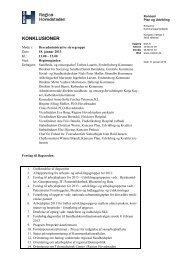Territorial Review Copenhagen - Region Hovedstaden
Territorial Review Copenhagen - Region Hovedstaden
Territorial Review Copenhagen - Region Hovedstaden
Create successful ePaper yourself
Turn your PDF publications into a flip-book with our unique Google optimized e-Paper software.
72<br />
left <strong>Copenhagen</strong> to go to a foreign country. This has left <strong>Copenhagen</strong> with a<br />
net annual inflow of around 800 people, without taking into account interregional<br />
migration flows within Denmark. Large net outflows from<br />
<strong>Copenhagen</strong> went to Sweden (probably attracted by cheaper housing) and<br />
the United Kingdom over 2000-07; while in the same period, <strong>Copenhagen</strong><br />
witnessed a net inflow from several countries, mostly from Germany,<br />
Poland, India and China. 24 No information is available on the qualifications<br />
of these people. It is important to note in order to avoid brain drain, the skill<br />
level of incoming migrants should be at least similar to those of Danes<br />
leaving the country. We have not been able to establish whether this is the<br />
case, but as labour markets for talented people have become increasingly<br />
global, it is growing more likely that talented Danes will migrate to global<br />
cities that are prominent in certain economic sectors, for example, to<br />
London in global finance.<br />
Universities in <strong>Copenhagen</strong> and the Danish education system<br />
<strong>Copenhagen</strong>‘s institutes of higher education include five universities,<br />
ten schools of fine arts and culture and numerous university colleges. Of<br />
these universities, educating around 65 000 students per year, two are broad<br />
multi-faculty universities, three are single-faculty universities and one is a<br />
business school. The Øresund <strong>Region</strong> includes 12 universities, around<br />
150 000 students, 12 000 researchers and 6 500 PhD students (Øresund<br />
University, 2008). Main institutes in <strong>Copenhagen</strong> are the University of<br />
<strong>Copenhagen</strong>, the <strong>Copenhagen</strong> Business School and the Technical University<br />
of Denmark. The University of <strong>Copenhagen</strong> is the oldest university, with a<br />
very broad range of disciplines. The university awards more than 2 000<br />
degrees each year, including 450 degrees in the humanities and 500 in<br />
mathematics, chemistry, computer science, geography and biology.<br />
<strong>Copenhagen</strong> Business School awards around 800 degrees per year, of which<br />
90% are masters in economics and business administration. The Technical<br />
University of Denmark awards about 700 degrees per year (OECD, 2005). A<br />
university reform has merged several universities into larger ones.<br />
The multi-faceted tertiary education system is considered to contribute<br />
to the competitiveness of the Danish labour market. Universities have much<br />
flexibility in the types of courses they can offer. The Danish tertiary<br />
educational system includes several highly differentiated streams, including<br />
short, medium and long tertiary education courses. Short tertiary education<br />
primarily leads to specialised degrees supplementing professional education.<br />
Most of these programmes target the private sector and are characteristically<br />
development-based. Medium tertiary education primarily targets professions<br />
in the public sector. Programmes are typically development-based and<br />
research-related. Long tertiary education targets specific job functions on

















